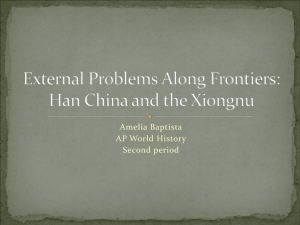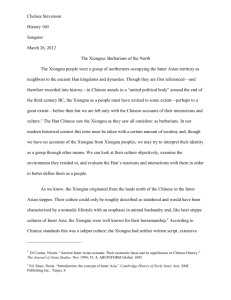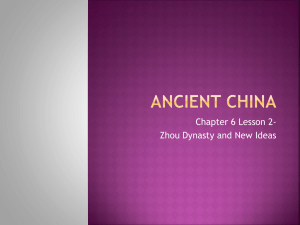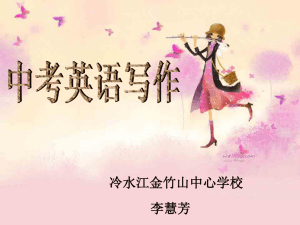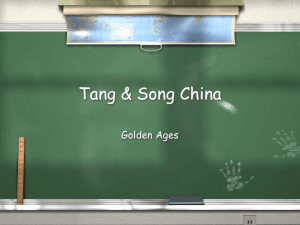Multicultural China in the Early Middle Ages
advertisement
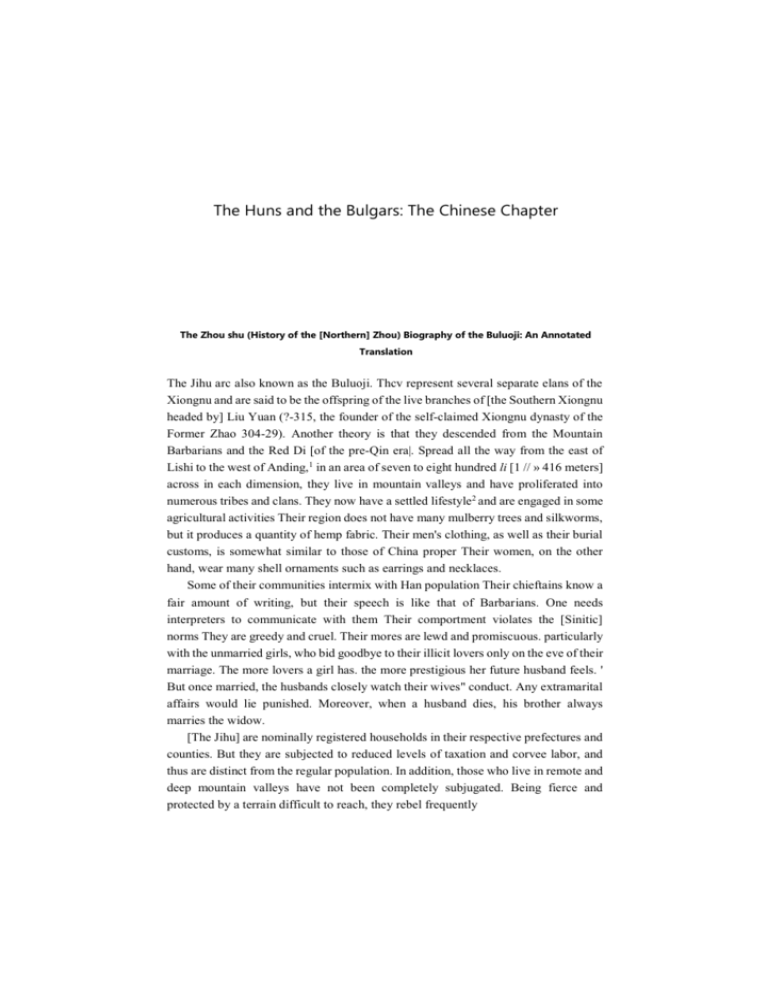
The Huns and the Bulgars: The Chinese Chapter The Zhou shu (History of the [Northern] Zhou) Biography of the Buluoji: An Annotated Translation The Jihu arc also known as the Buluoji. Thcv represent several separate elans of the Xiongnu and are said to be the offspring of the live branches of [the Southern Xiongnu headed by] Liu Yuan (?-315, the founder of the self-claimed Xiongnu dynasty of the Former Zhao 304-29). Another theory is that they descended from the Mountain Barbarians and the Red Di [of the pre-Qin era|. Spread all the way from the east of Lishi to the west of Anding,1 in an area of seven to eight hundred li [1 // » 416 meters] across in each dimension, they live in mountain valleys and have proliferated into numerous tribes and clans. They now have a settled lifestyle2 and are engaged in some agricultural activities Their region does not have many mulberry trees and silkworms, but it produces a quantity of hemp fabric. Their men's clothing, as well as their burial customs, is somewhat similar to those of China proper Their women, on the other hand, wear many shell ornaments such as earrings and necklaces. Some of their communities intermix with Han population Their chieftains know a fair amount of writing, but their speech is like that of Barbarians. One needs interpreters to communicate with them Their comportment violates the [Sinitic] norms They are greedy and cruel. Their mores are lewd and promiscuous. particularly with the unmarried girls, who bid goodbye to their illicit lovers only on the eve of their marriage. The more lovers a girl has. the more prestigious her future husband feels. ' But once married, the husbands closely watch their wives" conduct. Any extramarital affairs would lie punished. Moreover, when a husband dies, his brother always marries the widow. [The Jihu] are nominally registered households in their respective prefectures and counties. But they are subjected to reduced levels of taxation and corvee labor, and thus are distinct from the regular population. In addition, those who live in remote and deep mountain valleys have not been completely subjugated. Being fierce and protected by a terrain difficult to reach, they rebel frequently 84 Chapter 4 During the Xiaochang period (525-27) of the [Tuoba] Wei dynasty, there was a [Jihu chief] Liu Lisheng in the Valley of Yunyang,' who proclaimed himself the son of heaven, declared a reign title (Shenjia, "sacred auspiciousness"), and appointed court officials. This was during the chaos of the Wei rule, and the government was unable to launch a military campaign [against them] Consequently. Lisheng divided his troops and dispatched his followers to pillage the sedentary populations. There was scarcely ever a peaceful period in the regions between Fen and .Tin.' After the move [of the Tuoba Wei capital from Luoyang] to the city of Yc, [Emperor] Shenwu ("godly martialness") of the [Northern] Qi' started plotting secretly against Lisheng. He falsely promised to marry his daughter to the heirapparent son of Lisheng Lisheng believed the proposal and dispatched his son to the city of Ye. Shenwu of the Qi bestowed an extravagant amount of dowry (it was in fact a betrothal gift) but delayed the marriage date. Deceived by the promised marriage alliance, Lisheng let down his guard. In the third month of the first year of Datong (535), Shenwu of the Qi launched a surprise attack with a commando force Lisheng [hastily] led a light cavalry unit to mobilize troops and was killed by his own Prince of the North, who sent Lisheng's head to Shenwu of the Qi Lisheng's followers enthroned Lisheng's third son, the Prince of the South Sea. and organized military resistance But Shenwu of the Qi destroyed the regime, captured the bogus monarch, together with his brother, the Prince of the West Sea, his empress and concubines, and more than four hundred persons from princes and dukes on down, and returned to the city of Ye Many Jihu who resided to the west of the [ Yellow] River. 7 entrenched in their precipitous locations, did not submit [to the Northern Zhou and its predecessor, the rump Western Wei (535-56)]. [The Yuwen regime] was initially battling Shenwu of the Qi for supremacy and could not confront the Jihu. Emperor Taizu [of the Zhou] s therefore dispatched Gentleman of the Palace Gate Yang Biao to placate the tribes In the fifth year [of Datong. or 539], the Black-water" clans rebelled first, followed in the seventh year (541) by another | Jihu| chief. Liu Pingfu. the regional inspector of the Xiazhou commandery.'0 who took possession of the prefecture of Shangjun." After that, various [Jihu] tribes in the Northern Mountains'2 violently pillaged year after year. Emperor Taizu successively sent off Li Yuan, Yu Jin, Houmochen Chong, and Li Bi (biographies: Zhou shu 25.418—22, 15.243—50, 16.268-70, and 15.239-41, respectively) to pacify these rebellions. At the beginning of the Wuchcng period (559-60), the Jihu of the Yanzhou commandery13 Mao Abao andl-Iao Langpi ("wolf's skin") led their clans to declare allegiance to the |NorthernJ Qi. Abao named himself the prime minister, and Langbi Huns 85 appointed himself the Pillar of State. They set up mutual support with another [Buluoji] chief, Liu Sangde Under the command of the Pillar of State DouluNing (biography: Zhou shu 19.308-10), the Zhou military units joined the regional inspector of the Yanzhou eommandery Gao Lin (biography: Zhou shu 29.495-97) to defeat the Buluoji. In the second year (560), Langpi and the remaining collaborators rebelled again. The emperor decreed an expedition led by Grand General Han Guo (Biography: Zlwiishii 27441-42), who captured and killed a large number of rebels. During the Baoding period (561-65). the Raw Barbarians" of Lishi came repeatedly to pillage the northern banks of the Fen river. The regional inspector of the Xunzhou eommandery" Wei Xiaokuan (biography: Zhou shu 31.535-44) built forts in vital locations and stored military provisions in order to block the Jihu's traveling routes When Yang Zhong16 joined with the Turks to attack the [Northern] Qi, the Jihu again entertained thoughts of insubordination and refused to supply provisions for the campaign. Zhong then bluffed the Jihu chiefs by threatening to attack them instead, using the Turk troops The [Jihuj chiefs were intimidated into supplying the provisions. See the [Zhou shu] biography of Zhong for details Afterward, the Jihu clans in the commanderies of Danzhou. Suizhou and Yinzhou, together with another chief. Hao Sanlang of Puehuan," rebelled for years The emperor successively ordered Daxi Zhen. Xin Wei, and Yu Shi (biographies: Zhou slm 19.306-7. 27447-48. and 15.250-51, respectively) to conduct all-out campaigns against them and to disperse their clans and tribes In the second year (567) of theTianhe period (566-71). the Area Commanderin-chief of the Yanzhou commandery Yuwen Sheng (biography: Zhou shu 29493) led troops to erect a wall around the seal of Yinzhou commandery Bai Yujiutong, Qiao Shiluo, and other Jihu chiefs plotted to intercept Shengs troops by surprise. Sheng killed all these leaders and also defeated their other chieftains including Qiao Sanwutong. In the fifth year (570). Commander Liu Xiong (biography: Zhou sliu 29.503-5) went to examine the rivers and routes in the northern frontier by way of Suizhou.18 Several Jihu chiefs, including Qiao Bailang and Qiao Suvvu, crossed the | Yellow] River to intercept Xiong. but again they were defeated by Xiong In the fifth year (576) of the Jiande period (572-77). Emperor Gaozu (Yuwen Yong. 543-78. the fourth son of Yuwen Tai and the third sovereign of the Northern Zhou), defeated the [Northern] Qi forces at Jinzhou. 19 In hot pursuit of the enemy upon this victory, [the Zhou forces] did not have time to collect the armor and weapons abandoned by the Qi soldiers. The Jihu took advantage of this opportunity and stealthily emerged to steal those pieces of equipment. They set up the grandson. 86 Chapter 4 Meduo, of Lisheng as their leader, naming him Emperor Shengwu ("sacred martialness") with the reign title of Shiping ("rock peace"). In the sixth year (577) Emperor Gaozu ("High Ancestor. Progenitor") pacified Eastern China (i.e., destroyed the Northern Qi regime, which had ruled the eastern part of the former Tuoba Wei realm) and wanted to demolish the Jihu regime as well It was decided that the Zhou forces should pursue them all the way to their deepest hideouts. But [ Yuwen] Xian. the Prince of Qi (544-78; the fifth son of Yuwen Tai, biography: Zhou shu 12 187-96), observed that there were numerous clans and tribes of the Jihu residing in the mountains and valleys that were difficult to penetrate. It was not possible to annihilate all of them in a royal expedition. One should instead exterminate their leaders and summon the rest to surrender Emperor Gaozu consented to this suggestion and appointed Prince Xian as the campaign marshal for this expedition, commanding several campaign commanders: [Yuwen] Zhao, the Prince of Zhao; [Yuwen] Jian. the Prince of Qiao; [Yuwen] You. the Prince ofTeng; :0and others to attack (the Jihu]. After stopping at (the Town of] Mayi, 21 Prince Xian divided up the forces to advance simultaneously via different routes. Meduo dispatched his partisan Tianzhu to defend the east bank of the [Yellow] River and his grand general Mu Zhi to guard the west bank of the | Yellow| River, with the intention of defending the crucial locations, and separating and counterattacking Xian's forces Xian ordered Jian. the Prince of Qiao, to attack Tianzhu. and You. the I'rmce of Teng. to attack Mu Zhi. Both succeeded in destroying their respective opponents, and beheaded more than ten thousand enemies. Zhao, the Prince of Zhao, captured Meduo. and the rest of the Jihu all surrendered. In the first year of the Xuanzheng period (578). the Jihu chief Liu Shouluoqian of the Fenzhou commandery rebelled again. Troops under the command of (Yuwen] Sheng. the Prince of Yue" (biography: Zhou shit 13.204-5), attacked and captured him. Subsequently, the rebellion and pillage have significantly subsided. The Origin and Ethnic Affiliation In the early sixth century, when the Tuoba Wei dynasty disintegrated in the wake of the Six-Garrison Revolt, there appeared in northern China a "Barbarian" group with tlie name Buluoji (Middle Chinese pronunciation b 'uo-lak-kiei). In Chinese records, this name was often shortened to Jihu. "the Ji-Barbarian " The use of the term hit, previously referring specifically to the Xiongnu, but gradually becoming a generic appellation for assorted groups of "Barbarians," is itself an intriguing subject, to be examined later in this chapter. The late Peter Boodberg was the first Western author to Huns 87 study this group 2' I lis identification of the ethnonym Buluoji with that of the Volga and Danube Bulgars, though, raises both serious problems and intriguing connections. A summary account of the Buluoji is found in Chapter 49 of Zhou shu (History of the Zhou, pp. R97-99), of which I have provided the preceding annotated translation. This most comprehensive description of the Buluoji has been copied or abridged by several classic encyclopedic sources, namely Tongditm (The Comprehensive Statutes), Taiping huanvu ji (.-1 Description of the World of Great Tranquility), Tongzhi (General Treatises), and Wenxian tongkao (Comprehensive Examination of Source Materials)}' Brief passages related to the group are scattered in fiei slii (History of the Northern Dynasties), Bei Oi shu (History of the Northern Oi). Zhou shu. and other minor sources The near- exhaustive compilation of Xiongnu materials by the Chinese scholar Lin Gan2' represents perhaps the most complete collection of Buluoji data, while Zhou Yiliang and Tang Changru have each done an extensive study on the Zahu ("mixed or miscellaneous Barbarians"), of which the Buluo ji was regarded as a component24 According to the account of the Buluoji in Zhou shu,-1 they were "the separate clans of the Xiongnu" and were the descendants of the followers of Liu Yuan, the founder of the Former Zhao Dynasty (304-29) Though Liu Yuan's own ethnicity, especially whether he was a "pureblood" Xiongnu person, is open to debate, the Former Zhao has been generally regarded as a Xiongnu regime. This earliest account of the origin of the Buluoji appears to be at least partially accurate, namely in that they contained in great part the remnants of the Xiongnu confederation that had not been absorbed by the Xianbei Besides the Zhou shu testimony, additional evidence includes the following: opening statement of the Jihu biography. In addition, the county of Lishi mentioned repeatedly by the Jihu biography happened to be the very first capital of Liu Yuan, the founder of the Xiongnu Former Zhao dynasty. 2. Several Buluoji clan names, particularly those of the leading clan Liu, plus Iluvan and Qiao, were well-recognized Xiongnu names.28 1 Taipinghuanyu ji (35 292) quoted a Sui dynasty (581-618) source on a contemporary popular saying that the Buluoji were HutouHdnshe ("Hu-headed but Han-tongued"). This shows that, after apparent simlication (Hiin- tongued). the Buluoji still maintained their distinct physical appearance. 88 Chapter 4 3 The tiei Oi shu (27.378) biography of Poliuhan Chang, whose surname was but a variant of Buluoji, states unambiguously that the clan descended from the Xiongnu. 4 As will be further examined, the Buluoji belonged to a group or groups of "Barbarians" loosely called the Zahu during the Northern dynasties. According to Tang Changru (p. 444), the use of the name Buluoji actually superseded the use of the latter. Tang therefore concludes that the Buluoji represented the final amalgamation of the Zahu. Most Zahu groups can be linked with the Xiongnu in Chinese records Indeed, this old Xiongnu connection has other implications that will be discussed later Conversely, to judge by "the separate clans of the Xiongnu" characterization of Zhou shu. it is difficult to argue that the Buluoji represented the original core elans of the Xiongnu or their direct, "pureblood" descendants. 29 On the racial side, there were strong indications that the Buluoji included a conspicuous European or Caucasian admixture:,0 4. Another piece of evidence that the Buluoji's possessed Caucasian traits is the rather sudden change of the primary meaning of the Chinese character hu from referring to the Xiongnu to designating the Caucasian Central Asians, which happened to coincide with the appearance of the Zahu. With regard to their lifestyle, the /.lion slitt account clearly showed that the Buluoji were mostly settled at the time and partly engaged in agricultural pursuits However, one may not attribute this entirely to their apparent sinification (adopting Han dress and burial customs, etc , and eventually becoming "Han- tongued") or to the Central Asian elements among them. Modern archeology has revealed that, contrary to classical records, both the Xiongnu and F.uropcan Huns had maintained substantial agricultural activities.12 Despite the conspicuous Central Asian elements and settled lifestyle, we have solid evidence for the Buluoji's steppe cultural heritage Tang hu iyao (The Essentials ofTang Institutions), Jin Tang shu (Old History of the Tang), and Xin Tang shu (New History of the Tang) all classified Buluoji music as belonging to the Beidi "Northern Barbarians." Further, it was grouped together with that of the Tuyuhun and the Xianbei. The latter two groups' Altaic affinity is beyond doubt. Last but not least. Tang liuiyao and Jill Tang shu both noted that the music was of the "cavalry" genre. Given the familiarity and popularity of Central Asian music during the Tang era. exemplified by none other than the famous poet Bai Juyi of Central Asian ancestry, the sub- Huns 89 ject of Chapter 7 of this book," these official records separating Buluoji music from that of the "Western Barbarians" are strong proof of the Buluoji's nomadic past The Buluoji's steppe cultural identity is further strengthened by the limited linguistic data A few surviving and identifiable words of the Buluoji all seemed to be Altaic. Turkic in particular. Peter Boodberg has identified btli, "slave." and keye, "fort".'41 note that the Buluoji word weiya (jwei-nga). referring to some kind of wetland tree (Taiping huanyu ji 35.293) can be identified with middle Turkic yiyac, "wood," "tree or shrub."" Another toponym, Kutuo. identified by Boodberg with the Mongolian word kuda,K was also from the area populated by the Buluoji (but note that Edwin Pulleyblank has raised doubts on the claim that the leading elements of the Xiongnu were Altaic See below ). To this I add yet another piece of data: in describing the music of the "three northern-barbarian states" namely the Xianbei. Tuyuhun. and Buluoji, Jiu Tang shu (29.1072) states that their songs sung the name kehan or Oaghan frequently, and this was particularly the case with a chapter called Bohiohui. an apparent variant of the root buluoji Thus we learn that the Buluoji called their ruler Oaghan. a distinct Altaic trait, though the title itself may not be of Altaic origin. To summarize, (he Buluoji, or the Bulgars of China according to Boodberg, appear to be a group that consisted of the remnants of the Xiongnu confederation that were not absorbed by the succeeding Xianbei conglomerate, with a conspicuous Europoid admixture. Their cultural and linguistic affinity seems at least partially Altaic A Mixed Race or "Troublemakers"? Before \vc go back to Boodberg's debatable identification of the Buluoji with the Bulgars and the latter ethnonym's equally controversial etymology, there is the intriguing question of whether the Buluoji represented a mixed race. As presented earlier, the Buluoji not only was one of the many Zahu groups of the era but also signified the final amalgamation of such groups. A general question then is what did Zahu stand for? Here Zahu is the short form of Za- zhong Hu, hence often simply rendered Zazhong. The term zazhong has had the dual meaning of "miscellaneous races" and "crossbred races " The exact meaning of Zazhonghu thus becomes a perennial controversy between these two interpretations. Such divergence is not unexpected as the Latin root of the English word "miscellaneous" means "mixed." 90 Chapter 4 There is a noteworthy connotative issue that again is not a unique Sinitic phenomenon, namely that zazhong has always been a term of insult and spite, in both medieval and modern contexts For example, in the year 505. Qiu Chi (463-508). an official of the Southern Liang (502-57). wrote a letter to Chen Bozhi. a southern Han general who had earlier surrendered to the Tuoba Wei dynasty. This famous letter contained such sinocentric statements as this (Liang shu [History of the Liang), 20.314-15): "Hence I know that wherever frost and dew are fair and even, the alien races cannot procreate: and the old country of the Ji (the imperial clan of the Zhou dynasty) and the Han is never meant to accommodate those crossbreeds (zazhong)" Evidently, similar bias against and contempt for "crossbred races" existed in Western culture as well, so much so that, despite Boodberg's learned comment on this issue many decades ago. a noted Sinologist of Western origin, in reviewing an early manuscript of mine on this subject, seriously questioned the possibility that any self-respecting human group would have called itself a "mixed race.'' But such Eurocentric and Sinocentric sensitivities may not be appreciated at all by many ancient as w ell as modern groups who did not find being of a mixed race in any way dishonorable. An example is the medieval tribal group in northern China named 'l'iefu. IS ei shi (History of the Northern Dynasties 93.3062. see also Wei shit 95.2054) records, "In the north, people call by the name Tiefu those whose father is xiongnu and whose mother is Xianbci And this has been taken [by themselves] as their clan name." In other words, this is a clear case that a northern group had taken a word meaning "Xiongnu father and Xianbci mother" as their sclf-identitv. Moreover, a famous chieftain, Ilehan Bobo (?-425), of this group, who founded the ethnic Xia dynasty (407-31). later thought it necessary to adopt a new royal surname, Helian, meaning "(directly from) heaven " But despite the Sinocentric description of Bei shi and Wei shit that this was prompted by the "shame" associated with the name Tiefu,37 Helian Bobo ordered the rest of his fellow clansmen to proudlv keep the old "Xiongnu-fathcr-and-Xianbei-mothcr" clan name, albeit with a more forceful Chinese transcription Tiefa ("Iron- strike"), so that (Jin slut 130.3206) "their descendents are as solid and sharp as iron, capablc of striking other people." More than a millennium later and far away from the Old Eurasia, new "mixed races" w'erc created on the New7 Continent when early European settlers mingled with the aboriginals And again, words such as Metis and Mestizos, unmistakably meaning "crossbred." have been taken as proud self-identifications of these mixed people in both Americas up to the present dav. is The conclusion is that, a proud elan name meaning "mixed race" was and is quite normal outside the Sino-European cultural orbit. Huns 91 Back to the Buluoji and the general Zahu "Barbarians" during the Northern dynasties, there are indeed earlier precedents for zahu to mean "miscellaneous barbarians." For example, in Sangtto zhi (History of the Three Kingdoms 16.512-13), this word was used interchangeably with zhuhu ("various Barbarians"). But in the Hon Han shu (Histoiy of the Later Hcut 76.2463) passage on zazhong httji ("zazhong Barbarian cavalry"), a military unit from a group later identified as one of the Zahu groups, indicates that the Zahu of the Northern dynasties was evidently short for zazhong hit As such, the term in all likelihood should be understood in the context of "mixed races " The best example is the case of An Lushan, a self-acknowledged son of a Turk father and an Iranic/Sogdian mother (Jiu Tang shit 104 .3213. and ZZTJ 216.6916). An was thus called a zazhong hu (Jilt Tang shu 150a 5367). correctly translated by Edwin Pulley blank as a "hit barbarian of mixed race."" In addition, as the translated Zhou slut biography states, the Buluoji "represent the separate clans of the Xiongnu. and are the offspring of the five branches of Liu Yuan." It is of particular interest that the other self-identified "mixed race" of the period, namely the Tiefu, later Tiefa. had a nearly identical pedigree. being the descendants of the Xiongnu and coming from the clans of Liu Yuan (.Jin shu 130.3201). I would further poml out that Liu Yuan's own assertion of noble Xiongnu lineage was rather questionable Though the claim that Liu's elan was once part of the Southern Xiongnu confederation appears credible, by its very name, Tuge or Xiutuge (also shortened to Xiutu), the group was unlikely to be "pureblood" or unadulterated Xiongnu. It was already called zazhong by Hon Han shu (76.2463) and was later characterized as a Zahu group, which indicated the gradual ethnic blending when the old Xiongnu confederacy began to be supplanted bv other nomadic powers, particularly that of the Xianbei, a process leading to the appcarancc of many "mixed Barbarians." The last piecc of the puzzle is the insightful observation by Tang Changru that the Buluoji represented the final amalgamation of such "mixed Barbarians" cited earlier. To summarize all the evidence. Chinese data including the strong Caucasian elements support the notion that the Buluoji represented a "mixed race." Meanwhile, history records also that the Buluoji and in general the Zahu had been a perpetual "security problem" for the Tuoba Wei dynasty and its successors, namely the Northern Zhou and the Northern Qi, as well as the Sui and the early Tang, to pacify The histories of these dynasties were filled with incidents of Zahu insurrections and revolts, as well as the government's continued efforts to subdue or mollify them. Indeed, even during the early Tang, the appearance of the name Buluoji was almost always related to such upheavals. The perennial strife between the Zahu/Buluoji on 92 Chapter 4 one side, and the Tuoba and its successor stales on the other side, appeared to be a carry-over of the old Xiongnu-Xianbei rivalry40 In this context, as expressed explicitly by Zhou shu. the Buluoji tribes were constant troublemakers in the eves of the Tuoba rulers of the Northern dynasties and their Sui and Tang successors. Incidentally, the "Xiongnu-father-and-Xianbei-mother" Tiel'u clans mentioned earlier had a similar repute Not only they were almost always rebelling or fighting against the Tuoba and other Xianbei groups, their leader Helian Bobo gave the name Tiefu a new spin—Tiefa. "iron-strike," a clear warning to his enemies that this "mixed race" was not to be trilled with. One is templed to ascribe such "troublemaker" character to a mixed group's inherent difficulty in conforming to mainstream populations. The Xiongnu and the Ethnonym Hu Whether direct progeny or "separate clans," the Buluoji represented the very last fragment of what was once the mighty Xiongnu conglomerate. As such, they provide some rare input to the perennial question of the Xiongnu's ethnic and linguistic identity This identity has remained to this day an enigma, despite centuries of extensive interactions with the two Han dynasties and their successors, both in violent warfare and through peaceful exchanges. The question is, were the Xiongnu Mongols? Or Turks? Or neither? Like the linguistic identity of the Tuoba discussed in the appendix of this book, the primary difficulty is that there is precious little linguistic data available, and that mostly in the form of words and names transcribed into (early) Chinese Ever since Sluratori Kurakichi started the research on this subject early last century, the issue for quite some time was the choice between a Mongolian and a Turkic identity for the Xiongnu. Shiratori seemed to have hesitated between the two characterizations. 41 Then Otto Maechen-Helfen observed that there lived in the Xiongnu Empire the ancestors of the present-day Ket or Yeni- sei-Ostiaks, and some of the Xiongnu words might have been borrowed from the Proto-Kct.4- A little later Lajos (Louis) Ligeti made the first attempt to prove the Kcttic affiliations of the Xiongnu. 4' Likely enlightened by these attempts, Edwin Pulleyblank in 1963 advanced the theory based on linguistic data that the Xiongnu might not be Altaic at all He proposed that the Xiongnu language belonged to the Yenissei group, with Kettish as its modern relative.44 This proposition has kept attracting scholastic attention. 45 It is of particular interest that the same Yenissei groups have also been linked, with some degree of success, to the Sino-Tibetan linguistic family46 The Xiongnu Huns 93 language problem would therefore seem to have come full circle Indeed. I have observed possible proto-Sinitic linguistic connections of the Xiongnu. including the aforementioned clan name Helian that has survived in China to this day. 47 Related to this issue is an old yet elusive puzzle in Xeno-Chinese relationships. namely the change of the primary meaning of the character hit. From the two Han dynasties until well into the Southern-Northern dynasties, Hu as an ethnonym had primarily referred to the Xiongnu (and members of their confederation). For instance, a Jin dynasty source still clearly states hit was the general name for the Beidi ("Northern Barbarians").48 But during the Tang. Hu became largely reserved for Central Asians or "Western Barbarians." This issue has attracted the attention of several prominent scholars.4' None has provided a satisfactory explanation for this rather sudden change in the meaning of the character Int. For example, both Wang Guowei and Cen Zhongmian tried to explain the character hit's double meaning by alleging that the Xiongnu were largely Caucasian or had an Iranic origin, which, while insightful, went beyond what could be supported by historical and archeological data. Though the Buluoji could not with certainty be traced back to the hardcore Xiongnu, the disintegration and dispersion ot'the latter under the growing Xianbei pressure and dominance apparently resulted in the appearance of various Hu groups, leading to the summary Zahu designation with the Buluoji as its last representative. This process is relatively well documented in Chinese sources. For example, Jin shu (56.1533-34) mentions that the I lu of Bingzhou "had in fact been the Xiongnu." Bingzhou in due course became a major homestead of the Buluoji The cited studies by Tang Changru and Lin Gan contain other well-documented cases While we still cannot answer with certainty the question of ethnic identity, the reconstruction of the process of its breakup inevitably leads to the inference that the original Xiongnu federation had a major F.uropoid component For one thing, the largely Indo-Iranic Central Asian oases and city-states had for a long time been under the Xiongnu's direct control, even regarded as its "right arm " Some had demonstrated unwavering loyalty to the Xiongnu under Han pressure Maenchcn-Hclfcn has also demonstrated the increasing Caucasian elements in the Xiongnu during and after the Han dynasties." At least we can conclude with much certainty that the end product of the breakup of the Xiongnu Empire included many Allaicized Caucasian groups. The Hephthalites. the War-Huns and/or the White Huns, and so on represented perhaps some of the groups who migrated westward." whereas the Buluoji and other Zahu groups remained behind. It is worth noting that from early on, as claimed by Sui shu (84 1862). even the Turks were also known to have descended from the Zahu." 94 Chapter 4 It is my opinion that the Buluoji may serve as the missing link for the change of the primary meaning of the Ini designation, which happened to coincide with the appearance of the Zahu in the Northern dynasties. A good case is the well-established equation that the Buluoji were widely known as Shanhu ("Mountain barbarians"). The latter name was still popular at least till the early Tang (as shown by Bei Oi shu. which was compiled during the Tang and persistently used "Shanhu" to refer to the Buluoji) Along this line 1 have identified an intriguing datum In the year 751. Tang troops led by Korean general Gao Xianzhi suffered a decisive defeat at the hands of the Arabs and local T Urk groups on the banks of the Talas River.5'' As a result, many Chinese became prisoners of war and were sent to the heartland of the Abbasid Arab Empire According to Joseph Needham. this event much accelerated the spread and transmission of Chinese technologies and inventions, papermaking in particular, to the rest of the world. 55 One such prisoner. Du I luan, eventually made it back to China via the ocean trade route and recorded his travels during this extraordinary experience, which included, inter alia, an eyewitness report of Chinese craftsmen working in the Abbasid Arab capital Aqula (Kufa). 56 Among the few precious remaining pieces of Du Huan's since-lost memoir Jingxing ji (TravelMotes), which are preserved in Tong dian, compiled by Du Huan's clansman Du You, one finds the following passage (Tong dian 193.1041): "In the countries I traveled through overland (from Central Asia to the Abbasid capital], there was but one kind of Shanhu ("Mountain Barbarians"], yet several different religions" Having lived in Central and West Asia for years. Du Huan was undoubtedly very familiar with the cultures and linguistics of this region For example, his accurate comments on Iran having been conquered by the Arabs more than one hundred years earlier were quoted by Du You to correct the out-of-date Chinese account of the old Sassanid Persia (Tong dian 193 1042). In addition. Du Huan's brief description of the three major religions current in the region appears rather precise. 57 Du had also accurately recorded the location of the Khazar "Turks" (Tongdian 139.1044). Therefore, his choice of the name Shanhu instead of the standard Tang period designation Hu for Iranic Central Asians is intriguing. In my view. Du's wording has both racial and linguistic underpinnings and very possibly reflects the flourishing of. if not the Buluoji per se. at least many Turkicized Iranic groups in the area, which was consistent with the subsequent Turkicization of much of the region. To recap, the fact that Buluoji was the last name for the Zahu was not a mere accident As examined earlier, the evolution of the Zahu included the increasing Caucasian elements in the former Xiongnu groups With the continued intermixing between the Xiongnu remnants and the Indo-Europeans both native in northern China Huns 95 and from Central Asia, coupled with the westward movement of many such groups, the name Hu acquired in a relatively short time its new primary designation. This may also have been a harbinger of Central Asia's Turkicization. Parallels between the Buluoji and European Bulgars Peter Boodberg's suggestion that the name Buluoji is a cognate of Bulgar raises two intriguing questions. The first is of course the solidity of this cognitive relation. and the second is whether the two ethnic groups were related On the one hand, there are scant data to support either claim, especially the second one. On the other hand, there are two interesting parallels between the Buluoji and the Bulgars that may be of some value to the study of both groups, and even to disprove a direct link between them First a brief digression to the enormously popular identification of the European Huns with the Xiongnu in Chinese records: W. B Henning's study of the "Sogdian ancient letters,"58 particularly about the Sogdian name .wn, was once acclaimed as having finally proved such a link 59 But Otto Maenchcn-Hclfcn soon pointed out the problems in this "final proof "60 While Iranologists tend to support Henning's conclusion, 61 Altaicists continue to discount this evidence and consider the theory yet unproven. 6The foremost parallel between the Buluoji and the Bulgars is in their respective progeny in relation to the Xiongnu and the Huns As I have presented, the link between the Buluoji and the Xiongnu confederation is well substantiated in that the Buluoji were clearly one of the remnants of the earlier Xiongnu Empire (but unlikely to have descended from whose dominant clans). Conversely, the Bulgars' connection to the European Huns has also been recorded ever since their first appearance in European history In fact, contemporary European sources kept equating the Bulgars with the Huns,6' so much so that the modern scholar D Detschev simply assumed that Bulgar was the name given to the dc- seendents of the Attilanic I luns by the Gcpids and Ostrogoths 61 Modern studies have also identified the name "Irnik" on the Bulgarian Princes' List with the youngest son of Attila, Ernach. 6' Gyula (Julius) Nemeth interpreted these old records as the intermingling of European Hunnic elements with newly arrived Oguric Turkic groups 64 At the very least, the Hun-Bulgar connection is much more tangible than the Hun-Xiongnu identification However, this parallel tends to disprove a direct link between the Buluoji and the Bulgars. especially in the case of the yet questionable Hun-Xiongnu equation This is because 96 Chapter 4 the European Huns could only be the descendants of the Northern Xiongnu, whereas the Buluoji were clearly, albeit very likely partially. descended from the Southern Xiongnu In addition to the original differences that prompted their permanent schism in AD 48. the two branches of the Xiongnu had further undergone centuries of radically different migrations, mterminglements. and evolutions6" in diverse parts of the Eurasian continent before the advent of the Buluoji and the Bulgars The second parallel is the meaning or etymology of the two ethnonyms. It is true that Boodberg's suggested cognitive relation between Buluoji and Bulgar lacks solid linguistic proof and may remain forever a conjecture.68 But an intriguing similarity can be observed between the two names. This is the controversial etymology of the name Bulgar In the early days of modern scholarship, there was the seemingly unanimous opinion that bulya means "to mix. to become mixed." Related to the lirst parallel, it is worth noting Maenchen-I Ielfen s conclusion that the European Huns were already "racially mixed."69 However, several alternative etymologies hav e since been proposed."" Of particular interest is the etymology "to incite, to rebel," later preferred by Nemeth who had earlier advocated the "mixed" theory71 Having earlier agreed with the old "mixed race" interpretation, Peter Golden too has switched to the new "disturbers" etymology.71 However, as presented earlier, these two rather different interpretations may not necessarily be mutually exclusive and can in fact coexist in the case of the Buluoji in China the group represented both a "mixed race" and a persistent "troublemaker" Moreover, about a century earlier, a "Barbarian" chieftain. Hclian Bobo, declared that his tribal name, Tiefu, originally interpreted as "Xiongnu father and Xianbei mother." also stood for Tiefa "iron-strike " This is clearly another case of similar doublemeaning of a Steppe-origin ethnonym. These parallels do not substantiate any direct link between the Buluoji and the Bulgar groups Nonetheless, one cannot help mentioning the latter's following possible contacts with the medieval East Asian world First there was the Arab author al-Nadim's statement that the Bulgars had once used the Chinese script as well as the "Manichacan script ""3 This rather cx- traordmarv story can tie discounted bv al-Nadim's poor repute in reliability. However. the Bulgars' use of the twelve-animal cycle is beyond doubt, as clearly shown by the famous Bulgarian Princes' List.74 This is not the place to delve into the origin of the animal cycle But as argued elsewhere in this book, recent archaeological discoveries and the Austroasiatic link uncovered by Jerry Norman75 make the China-to-Steppc transmission route of the animal cycle indisputable Omcljan Pritsak"'' may have gone too far by attempting to identify the most prominent clan. Dulo, on the Bulgarian Princes' List with the (Southern) Xiongnu clan name Tuge (Old Chinese pronunciation *d'o-k!ak) that happened to be the ancestor of the Buluoji and the name ofan important Zahu group to boot "The use of the animal cycle by the Bulgars may also be 97 attributed to their belonging to the OguricHuns (/ /■- according to Gerard Clauson) Turkic grouping who shared with the present-day majority "Common Turkic" peoples the heritage ofan ancient calendar based on the twelve-animal cycle as documented by Louis Bazin s The challenge to such an explanation is the historical fact that all other Inner Asian peoples, namely the 'lurks, the Tibetans, the Mongols, and various ancient Indo-lranie groups who used the animal cycle, had been in direct contact with the Chinese cultural world One perhaps needs more convincing arguments why the Bulgars. of whose calendar the animal cycle was a centerpiece, should be an exception The Buluoji in China had an enormous impact on Chinese history, political as well as cultural, which went largely unrecognized in the traditional sinocentric historiography I have already touched upon the Buluoji's political role. The best example must be the Six-Garrison Revolt, which eventually brought down the Tuoba Wei regime. It was first started and led by a person named Poliuhan Baling (ZZ7.7 149 4674) This somehow could be viewed as the final revenge exacted by the former Xiongnu groups on the Xianbei. who had earlier replaced the Xiongnu as the dominating power on the Steppe. What may have been neglected even more were the Buluoji's significant contributions to China's cultural and religious heritage For example, arguably the most prominent real-life figure in the vast Dunhuang grotto arts was the Buddhist monk Liu Sahe, who was of well-documented Buluoji ethnicity 79 But perhaps the least noted case was I.u Fayan, author of the single most important historical treatise on Chinese phonology, namely Oieytin (Tonic Rhymes) The late Chinese scholar Chen Yuan had only pointed out that I.u was a Xianbei person.80 without recognizing that the original form Buliugu of the sinified clan name Lu was yet another variant of the root Buluoji Even today, one cannot but marvel at the great accomplishments of such a presumably marginal "mixed Barbarian" group in medieval China 1. As convincingly demonstrated by Tang Changru (p. 443), the geographic distribution of the Buluoji as reflected in various records matched well that of the Southern Xiongnu during the Western Jin (265-316). In particular. the heavy concentration of the Jihu on the west bank of the Fen River coincided with the region occupied by "the five branches of the Southern Xiongnu" as recorded in Jin shu. This strongly supports the 2. Several clan names of the Buluoji and Shanhu ("Mountain Barbarians," a contemporary alternative ethnonym for the Buluoji as, will be explained later), such as Bai and Cao, were of typical Central Asian origin Zhou Yiliang (pp 151-53) went as far as to conjecture that the Buluoji were originally Central Asians from the Western Regions who migrated to northern China. Tang Changru pointed out that Zhou's claim could not be supported by the Buluoji's geographic distribution and the numerous old Xiongnu clan names. This issue will be further examined 3 If. as Tang Changru has concluded, the Buluoji were the final amalgamation of various Zahu tribes, then they naturally included the Jie, well known for their Caucasian, "high-nosed and heavy-bearded" physical features (227798.3100)."
